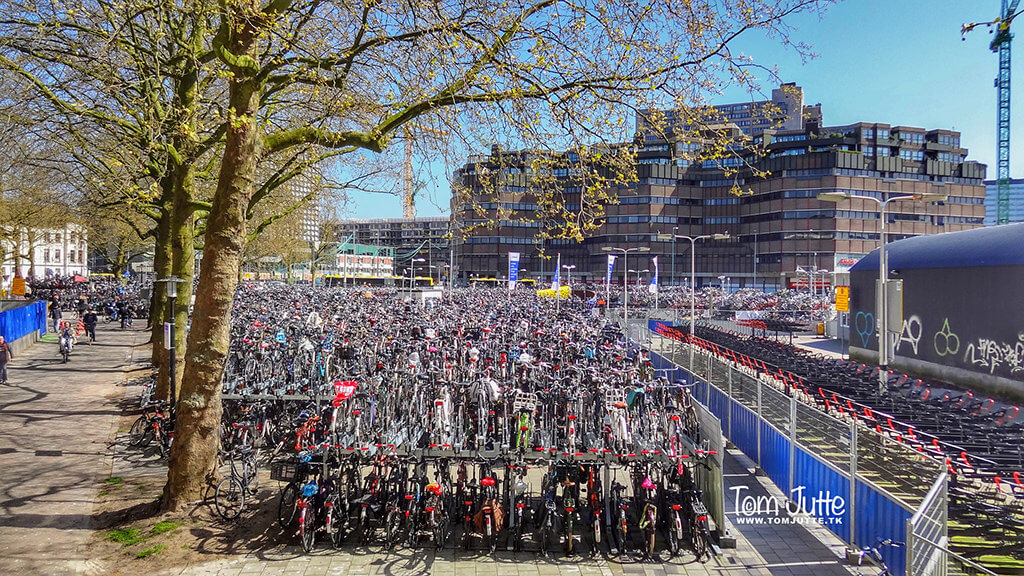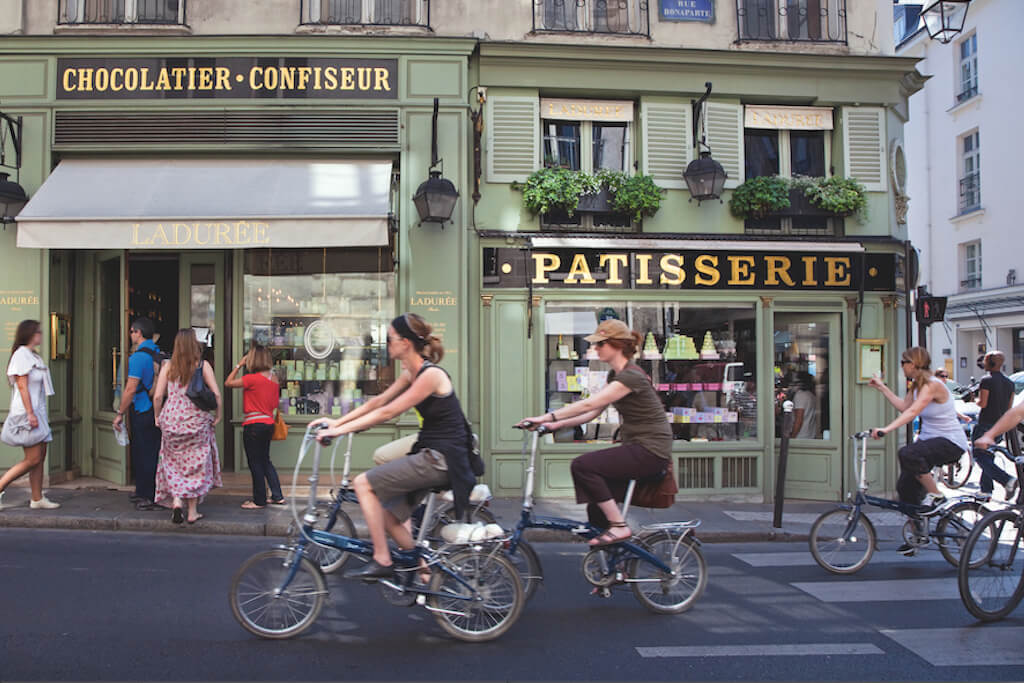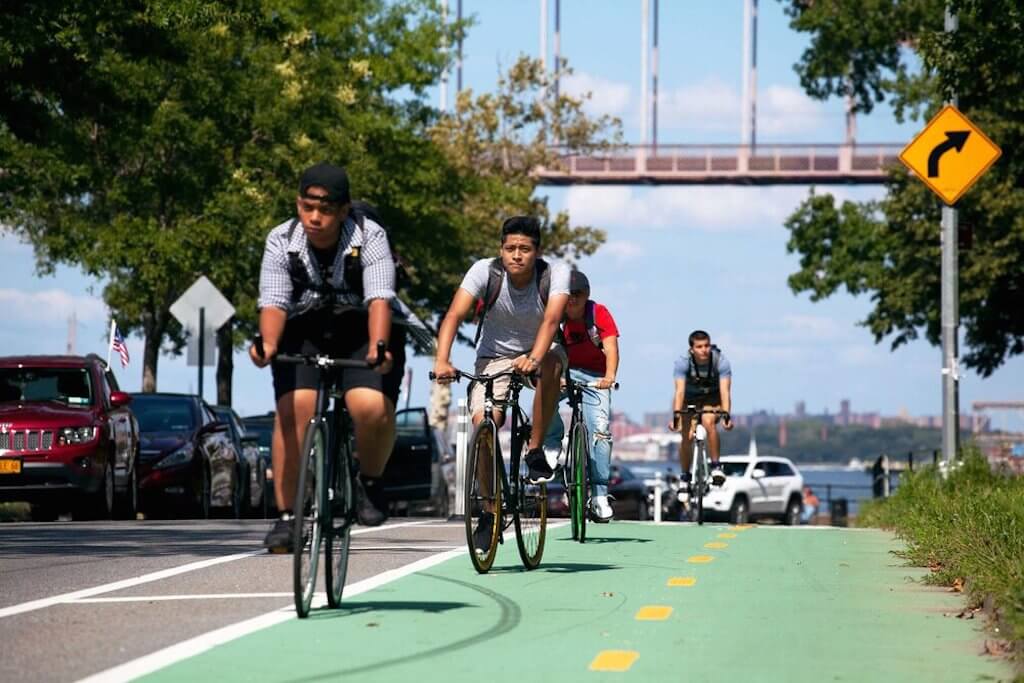Autumn Gear Guide
Find inspiration in our Gear Guide that will keep you out on your bike through wind or rain.
Download NowIn the olden times, the suggestion of giving up street parking spaces for bicycles was enough to generate a deafening roar of bike-riding pinko rhetoric from the powers that be in an attempt to quash progress on safe streets. Even when bike lanes were approved, they tended to be skinny lanes snaked haphazardly between parked […]
In the olden times, the suggestion of giving up street parking spaces for bicycles was enough to generate a deafening roar of bike-riding pinko rhetoric from the powers that be in an attempt to quash progress on safe streets. Even when bike lanes were approved, they tended to be skinny lanes snaked haphazardly between parked cars and active traffic creating death-trap corridors where cyclists are constantly worried about being doored by parked cars or flung into traffic. No longer. Since the pandemic-inspired boom in bicycles and greater attention to public space amenities, the script has, as they say, flipped. And it’s been a long time coming.
Now, separated and safe active transportation lanes hit so many sweet spots for municipalities it is impossible to avoid. Want to address the climate crisis? Get more people cycling by adding safe bicycle infrastructure. Want to combat congestion? Replace those clunky stink-bomb delivery trucks with e-cargo bikes for a start. Bicycles are a sure way to create awesome green jobs and help main street businesses thrive. Not to mention, more people cycling is likely to lead to a healthier and happier local population.
It’s no surprise that the Dutch invest hundreds of millions in cycling infrastructure and are repaid 10-fold by the savings in health care costs alone.

It’s something that Dutch cities such as Utrecht have been doing for years. Now, that city, in particular, is taking the next step and establishing a program where 750-1,500 parking spaces will be removed every year —0.5 to 1 perfect of the total number. In their place, parking hubs will be built on the outskirts of town and people will need to get to the core in different ways. To that end, 9,000 new bicycle parking spaces will also be added.
“By facilitating car parking on the outskirts of the city, space becomes available on the street for other functions and we make public space more attractive. In addition, fewer cars enter the city and we prevent roads from filling up,” a letter to the city council read. In addition, 9,000 new bicycle parking
This is a formula for success.
Right now, there is no more obvious example of a municipality embracing what the bicycle can do than Paris. Not only is the French municipality creating a massive cycling network, but it is also taking more and more space away from cars to give it over to the two-wheeled set, as well as other public space projects and pedestrians.
Under a new plan to remake Paris into a 100 percent cycling city, the government is removing 70,000 on-street parking spaces and turning them over to bicycles and other public space amenities.
Paris ends the squabble before it even begins.
How did they figure it out? According to the plan, 50 percent of public space is occupied by the car, despite it only accounting for far fewer trips in addition to the whole generating pollution leading to a climate emergency. So, Paris will take half of that space and repurpose it. Cycle paths will be part of that, but so will sidewalk development for pedestrians as well as park space.

“We can no longer use 50% of the capital for cars when they represent only 13% of people’s journeys,” said deputy mayor David Belliard, reported in The Times.
It’s a move that might have been unheard of in North America but times are a-changin’ and Paris’s move could spur on similar initiatives.
When the COVID-19 pandemic hit, cities across North America took the opportunity presented by masses of people working from home to redistribute roadway space to facilitate active transportation, outdoor dining, and creating more space for pedestrians to facilitate the need to get outside to socialize, stay physically active and maintain good mental health.
In Toronto, Canada’s largest city initiated its ActiveTO and CafeTO programs that saw an array of temporary active transportation lanes as well as outdoor dining and parklet spaces often put up across the city in place of on-street parking or taking away an active vehicle lane.
On the Danforth Avenue and Bloor Street corridors that run straight across the city smack dab in the middle of it all, separated bicycle lanes were jammed into space formerly dedicated to vehicles. Outdoor dining spaces were weaved into the mix and stretched for kilometers on end straight across the city.
Ontario, and the Greater Toronto Area especially, faced one of the stiffest and most challenging lockdowns on the planet. These outdoor spaces allowed many restaurants to survive, and many residents to keep active and get around the city without the need to use public transit or cars.
Now, the city is moving ahead with making the vast majority of these once-temporary spaces and bicycle lanes permanent, representing a massive increase in the cycling network to the tune of 65 kilometers of bikeways and 45 kilometers of enhances since the pandemic began with a long list of more on the way — 120 kilometers added since 2019.
“We are thrilled to support making these projects permanent,” said a group of city councilors focussed on the downtown core and east-end in a prepared statement. “We know that these pilot projects, including the patios, road safety improvements, and bike lanes, have and will continue to improve and protect the health of Torontonians, support local businesses, are an important step in fighting climate change, and most importantly make our streets safer for everyone.”
One of the most telling moves is the construction of separated bicycle lanes on a long section of Yonge Street, removing many on-street parking spaces and active car lanes as a result. Yonge is the city’s best-known roadway, symbolic of the culture shift, and these lanes will also be up for permanent approval in 2022.
Sure, there were a few people on city council who complained that people would have a more difficult time driving downtown. But, the comments sound more and more out of place, almost from a bygone era.

New York City was bicycle boom central during the height of the pandemic. As an example, cycling was up by more than 25 percent over the East River bridges.
New York City has already made some major moves over the past couple of years and none is more impressive and symbolic than making permanent new space for cyclists on the Brooklyn Bridge with the Queensboro Bridge up next.
It’s the culmination of years of advocacy work creating safe cycling infrastructure throughout New York City, and it comes at a time when people are discovering the joys of getting around the iconic metropolis by bicycle during the COVID-19 pandemic.
“We have other campaigns for other bridges, but specifically the three bridges that connect Brooklyn and Manhattan, we’re pushing for two vehicle lanes on each of those bridges, and increased bike infrastructure in the neighborhoods on either side of each of those bridges,” said Juan Restrepo of the advocacy group Transportation Alternatives earlier this year. “So it’s a wonderful win, and we need to celebrate it. And as I said, I think it signals a cultural shift, but it’s just the beginning of what we’re looking for.”
The biggest challenge and opportunity is right around the corner and comes with the recent election of bona fide city cyclist Eric Adams as Mayor.
It’s no surprise, bicycle-friendly mayors are getting elected across the planet as more and more people join the global bicycle brigade. Eric Adams promised a staggering 300 miles of separated bike lanes across the five boroughs of NYC in his campaign plan. Making this happen will require Adams to tap into the vast numbers of free or discounted vehicle parking spaces that line so many city streets.
“The big number is 3 million free parking spaces in New York City,” said Restrepo.
Transportation Alternatives initiated a bold campaign leading up to the election challenging city leaders to convert 25 percent of car space into space for people by 2025. Mayor-elect Adams was one of many who signed onto the pledge. Now that he’s elected, the hard work begins to ensure follow-through.
“We are thrilled that Mayor-elect Adams has throughout his campaign supported NYC 25×25 – our challenge, endorsed by over 200 local groups, urging New York’s next leaders to reclaim 25 percent of space for cars and give it back to people by 2025,” said Danny Harris, Transportation alternatives executive director. “As our city’s next mayor, Eric Adams can make NYC 25×25 a reality by expanding busways, protected bike lanes, and pedestrian space across all five boroughs. He can make 25×25 a reality by investing in permanent Open Street infrastructure. He can make 25×25 a reality by repealing the racist legacy of Robert Moses and investing in parks and public space.”
Blythe Austin, a volunteer co-chair of the Brooklyn Activist Committee of Transit Alternatives, explained that it will be important to correct the misconception of the working-class car owner.
“These are privileged people,” she said, in an interview earlier this year. “And if you walk around and look at the cars, they’re not being driven very often. I mean, it is literally car storage for most people. And in fact, you can’t really use a car to get around. In part, because there are no parking places, because everyone has their cars parked, and the only time they move them is maybe for street cleaning.”
Reclaiming the streets and turning those spaces over to bicycles and to public space amenities and safe spaces for pedestrians on that scale is revolutionary.
“Once you start thinking about okay, so if we’re going to deprioritize parking spaces and reallocate that space, what else could we use it for?” Austin explained. “It’s a huge amount of space. And people get excited when they think about how New York City would be a better place.”
Like what we are doing? To support Momentum please visit our page on Patreon. Thank you.
Find inspiration in our Gear Guide that will keep you out on your bike through wind or rain.
Download Now
Leave a comment